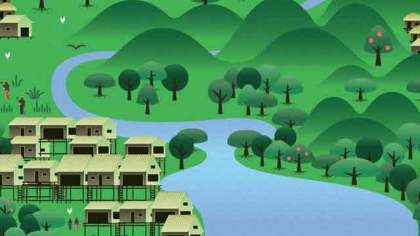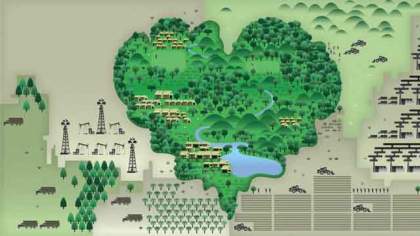-
What is 'Half a Million Hectares of Hope' about?
In the North East of Guatemala, amongst ancient Maya ruins and diverse tropical rainforest, lies one of the largest community-managed forests in the world. This video shares the good news story from ACOFOP in the Peten. It tells how indigenous and rural communities protect and sustainably manage 500,000 hectares of forests, while bringing a variety of economic and social benefits to local people.
Length of Video
12 minutes.
Background
The Association of Forest Communities of the Peten, known as ACOFOP, was set up by local communities in 1995. ACOFOP is a wholly community-led organisation that was born of the need to make the government of the time listen to the communities and realise that only by including the communities would it be possible to conserve the natural wealth of these forests.
Download 'Half a Million Hectares of Hope' here
Suggestions for Discussion Questions after community screenings
- How could your community cooperate to satisfy its needs without depending on large-scale development projects?
- What ideas does your community have for economic alternative development? (Timber, non-timber forest products, tourism, etc.). How could you take them forward?
- What practices, customary laws and knowledge do you have for the effective management and protection of your forests / territory?
- ACOFOP is a community-led organisation that represents the voices of the communities and lobbies for their best interests. Do you have any community-led organisations and how can they be strengthened?
Suggestions for Follow-up Activities after community screenings
- Think about your territory and community in terms of the strengths, weaknesses, opportunities and threats.
- Develop a strategy for alternative economic development of your community.
- Role-play activity: Imagine your community is campaigning to get a large, community-managed forest area like the one in this video. Prepare arguments to take to the government, showing the benefits which result when communities manage the land.
-
Documents and Downloads
The Palangka Raya Declaration on Deforestation and the Rights of Forest Peoples
"We, forest peoples, are being pushed to the limits of our endurance just to survive. Checking deforestation requires respect for our basic rights, which are the rights of all peoples and all human beings. Deforestation is unleashed when our rights are not protected and our lands and forests are taken over by industrial interests without our consent. The evidence is compelling that when our peoples’ rights are secured then deforestation can be halted and even reversed. We call for a change in policy to put rights and justice at the centre of deforestation efforts. The world cannot afford further delays." (The Palangka Raya Declaration, 2014)
Revealing the Hidden: Indigenous Perspectives on Deforestation in the Peruvian Amazon
The report, Revealing the Hidden: Indigenous Perspectives on Deforestation in the Peruvian Amazon was compiled by Peru’s national indigenous peoples’ organisation (AIDESEP) and international human rights organisation, Forest Peoples Programme (FPP) and is based on the analysis and perspectives of Peru’s indigenous leaders and organisations whose lives, lands and livelihoods are threatened by deforestation on a daily basis. (AIDESEP, 2014)
Other videos
CBFM Local Solution to Global Challenges
The video “Community Based Forest Management: Local Solutions to Global Challenges”expounds on the important role of community based forest management in indigenous peoples’ livelihood and food security; spiritual and cultural values; and climate change mitigation. The video focuses on the land use system of Lua (La-weu) indigenous peoples including sustainable practice of shifting cultivation in northern Thailand; and the challenges faced by the Bhagpani and Sitalupakha Women’s Community Forestry User Groups on forest management in Nepal. (The Asia Indigenous Peoples Pact / International Work Group for Indigenous Affairs / Indigenous Peoples’ Foundation for Education and Environment, 2014)
A Forest for Life. Forest management in Emberá Wounaan
A Forest for Life. Forest Management in the Embera Wounan Territory presents the achievements of this territory in the Panamanian Darien in the sustainable management of its natural resources. The video illustrates the progress and achievements of indigenous forest management through interviews with community leaders. Despite this progress, however, these Indigenous Peoples face a series of challenges in consolidating the sustainable management of their resources, including external pressures that threaten their territories, as well as regulatory and logistical obstacles. The experience demonstrates the capacity and potential for Indigenous Peoples as central actors in sustainable forest management and development based on their own cosmovision. (Alba Sud, 2013)
The Forbidden Forests of the Dayak, Borneo, Indonesia
Deep in the remaining old growth forests of Borneo, the Setulang Dayak village guards its forest with deep commitment. To date, the village's traditional law of Tana Olen (forbidden forest), withstands increasing pressure from encroaching logging industries. Now as rapid development rolls in, the village is trying to secure sustainable and forest-friendly future, including an eco-tourism venture and carbon credits (UNU-IAS, 2010).
Indigenous Peoples: The Guardian of Indonesian Forest
From Papua to Sumatra, representatives of indigenous peoples agree on the importance of forests. They have proven themselves to be the faithful guardians of Indonesian forests. From Papua to Sumatra, communities are facing similar troubles in the destruction of their forests: large-scale oil palm, plantation forest, and mining concessions. Can Indonesia’s indigenous communities protect more than 15 million hectares of currently pristine customary forests? To save lives, biodiversity, and global climate. This film urges everyone to think clearly, especially to the Indonesian government to place their complete trust in these communities to sustainably manage forests. (Telapak / Gekko Studio, 2011)
Fever: Resilience (English)
Resilience is the ability to cope and recover from abrupt change. Indigenous peoples who are organised, confident to adjust their systems to changing circumstances, while maintaining their identity strong, will be better able to withstand shocks caused by climate change. The film shows 5 examples of this: cultural resilience; traditional forest management; strengthening customary law to live within the limits of the environment; maintaining seed diversity; and adapting traditional systems to cope with water scarcity. (LifeMosaic, 2010)
Half a Million Hectares of Hope - Territories of Life
Guatemalan communities sustainably manage half a million hectares of forests while developing their local economies.
















